337 Search Results for communication boards
July 25, 2024
by Carole Zangari -
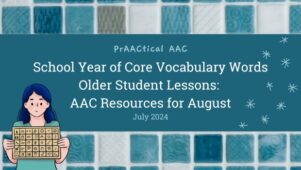
As we prepare for a new academic year, we’re delighted to reconnect with guest authors Michaela Sullivan and Lindsay Dougherty. Today, they kick off preparation for the upcoming school year with another wonderful set of Older Student Lessons in the School Year of Core Vocabulary Words series. Scroll down for some terrific resources, including two slide decks full of activities and the data collection forms specific to the Sugust core words. Their post also includes some helpful information on a key AAC support strategy, aided language input. SCHOOL YEAR OF CORE- Older Student Lessons Access & Copy below: Weeks 1-2 Google Slides Weeks 3-4 Google Slides INTRODUCTION- AUGUST 2024 Welcome back to the School Year of Core – Older Student Lessons: August! School is back in session for many and the summer is nearing the final stretch. Welcome back to the School Year of Core- Older Student Lessons (SYOC-OSL resource,... [Read More...]
June 6, 2024
by Carole Zangari -
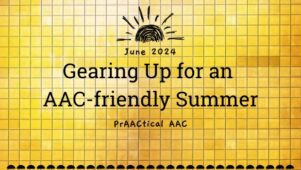
It’s almost time for a change in the seasons here in our part of the world. Today, we’re reaching into the archives for past posts with a summery bent and sharing some resources for summer-themed activities. Take a look. PrAACtically Reading with Karen Natoci: How Do You Know It’s Summer? A Recipe for Summer AAC Summer Reading A Few AAC Blog Suggestions 5 AAC Suggestions 3 Book Suggestions Apps to Prepare, Learn, & Talk About Summer Vacation Core Words & July 4th: Get Ready, Get Set, Go PrAACtical Summer Activities AAC-friendly Camps Summer Fun with AAC Other Resources for an AAC-friendly Summer From Susan Berkowitz Free Summer Communication Activities Calendar for AAC Speech Therapy Free AAC Core Vocabulary at the Beach Summer Communication From Ladybug Speech Summer Core Boards AAC From Melissa Clark AAC Core Word Summer Calendar From SLP Collective AAC Bug Hunt – Summer Activity From Traveling Talker Time Summer Polaroid Activity
May 23, 2024
by Carole Zangari -
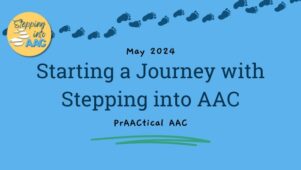
Welcome back to our series on using the Stepping Into AAC program materials, a self-study program for families seeking to learn about and begin using AAC with their child, teen, or adult. In today’s post, we explore some of the things to do in preparation for starting an AAC journey and move into the first week of AAC learning activities. As you begin your Stepping Into AAC journey, there are 3 main things to do. Think about how you will organize your AAC learning materials and make a plan for incorporating AAC into your life. Starting in Week 1, you’ll do hands-on learning with your communication board (or device/app), watch informational videos, and read through documents. Prepare to select a communication board to use throughout this program. LINK to coom boards If you’re unsure of which one to use, don’t let that stop you. We’ll give you some guidance on... [Read More...]
December 11, 2023
by Carole Zangari -
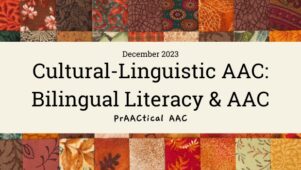
Our yearlong series on multilingual AAC support, guest-authored by BilingüeAAC, is drawing to a close. In today’s post, Melissa Tapia and Sarah Lee address AAC, bilingualism, and literacy. BilingüeAAC is a group of SLPs with a shared belief in providing evidence-based intervention strategies and resources to bilingual Spanish AAC clients, families, caregivers, and professionals. ::::::::::::::::::::::::::::::::::::::::::::::::::::::::::::::::::::::::::::::::::::::::::::::::::::::: Bilingual Literacy & AAC Welcome back to our Bilingue AAC Series! You can find our previous posts linked here, which wonderfully highlight best practices in bilingualism and AAC. (Post 1, Post 2, Post 3, Post 4, Post 5). We are excited to dive into our topic of bilingualism, literacy, and AAC and how we can effectively provide literacy intervention in culturally affirming ways with our Bilingual* AAC users. *Clarification: We address “bilingual populations”; however, the resources discussed are specifically for Spanish/English speaking populations. Several of the suggestions can be broadly applied to other languages. The goal... [Read More...]
September 16, 2023
by Carole Zangari -
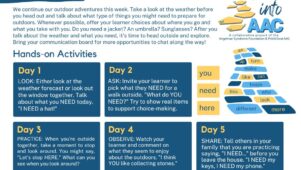
About This Week Welcome to Week 16 of your Stepping into AAC journey! We continue to add new words and deepen our understanding of AAC supports. You will explore the following concepts this week: AACtion Steps Week 16 AACtion Steps Signposts Get the Handout Commenting Travelog Week 16 Travelog Print the Week Want all of the resources shared in this week of Stepping into AAC? Download the entire digital bundle by clicking the download button below.
September 7, 2023
by Carole Zangari -
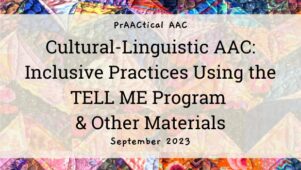
We are excited to continue our series on multilingual AAC support, guest-authored by BilingüeAAC. In today’s post, one member of the team, Melissa Tapia, addresses ways to use specific instructional materials with bilingual individuals. BilingüeAAC is a group of SLPs with a shared belief in providing evidence-based intervention strategies and resources to bilingual Spanish AAC clients, families, caregivers, and professionals. Inclusive Practices Using Tell Me Program & Other Materials How can we effectively conduct inclusive practices in our work settings? What are some approaches or materials that we can use to integrate the culture of the home and community? Why are inclusive practices essential for the success of our students/clients? These are fundamental reflective questions I have found to guide me in collaborative therapy and lead to better participation with and from my clients and their caregivers. We are Bilingue AAC, and we are here to provide helpful tools to... [Read More...]
April 7, 2023
by Carole Zangari -
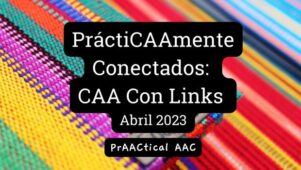
Each month we feature a Spanish version of our AAC Link Up, CAA con Links. If you have AAC-related announcements, materials, or videos in Spanish that you would like others to know about, we’d love to have you add that information below. Also, please share this with anyone who might be interested in contributing to or using the materials that get added to these posts. You’ll find the place to add that information at the very bottom of this post. Organized by Claudia Marimón, these monthly posts also feature AAC work being done in Spanish-speaking countries and offer translations of material that can help families and service providers. Today, she partners with Rita María Aceituno in focusing on the AAC support provided to Guatemalan children with Down Syndrome by Fundación Margarita Tejada. Enjoy the post, and remember to scroll to the bottom to add your link and see what others... [Read More...]
March 19, 2023
by Carole Zangari -
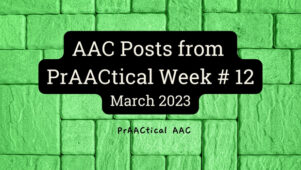
Happy Sunday, AAC friends. Here are some posts you might enjoy. Monday – AAC Implementation Framework: Step 2, TRAIN Tuesday – AAC Link Up Wednesday – Video of the Week: The Right to A Voice Thursday – Cultural-Linguistic AAC Intervention: A Framework for Consideration ::::::::::::::::::::::::::::::::::::::::::::::::::::::::::::::::::::::::::::: Looking for some AAC materials? We pulled out a few from the AAC Toolbox just for you. Spelling Boards & FlipBook– Letter boards (alpha & QWERTY) used at Camp Alec; Created by Tina Moreno Communicare Language Board Templates – Communication board templates for the post “How We Do It: Using Language Boards to Support AAC Use” Colorful Connections – Templates for teaching modified Fitzgerald Key and Goossens’, Crain, & Elder color-coding schemas And here’s a post from the past that you might like. Readiness: 7 Days of AACtion
March 13, 2023
by Carole Zangari -
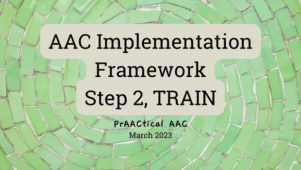
We continue to dive into our AAC Implementation Framework, guest authored by AAC SLP Vicki Clarke. In this post, Vicki discusses the way that she approaches AAC training when working with school teams. She shares lots of prAACtical ideas and resources to use in this process. You can see the earlier posts in the AAC Implementation Framework series using the links below. Steps to Learning Step 1, Determining the Target ::::::::::::::::::::::::::::::::::::::::::::::::::::::::::::::::::::::::::::::::::::::::::: AAC 101 Steps of Learning: TRAIN In Step Two, we begin the process of training HOW we say the word or message we are targeting. We are learning where the symbol lives on our AAC system, what it looks or sounds like, the motor sequence to navigate through pages on our AAC applications, and of course, signing or saying the word, if that’s appropriate. The most significant thing to remember at this step is that we are not specifically... [Read More...]
March 4, 2023
by Carole Zangari -
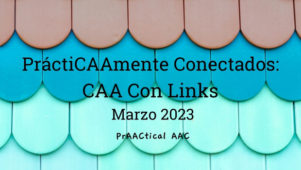
Each month we feature a Spanish version of our AAC Link Up, CAA con Links. If you have AAC-related announcements, materials, or videos in Spanish that you would like others to know about, we’d love to have you add that information below. Also, please share this with anyone who might be interested in contributing to or using the materials that get added to these posts. You’ll find the place to add that information at the very bottom of this post. Organized by Claudia Marimón, these monthly posts also feature AAC work being done in Spanish-speaking countries and offer translations of material that can help families and service providers. We are so delighted that today’s post focuses on literacy learning for children who use AAC as this is such an important topic for families and professionals to focus on. Meet Carolina and her charming son, Samuel, as they share ways they’ve... [Read More...]









